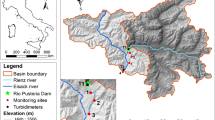Synopsis
The effect of siltation on stream fish in northeast Missouri was evaluated using community structural measurements and a functional approach that emphasized feeding and reproductive guilds. As the percentage of fine substrate increased, the distinction among riffle, run, and pool communities decreased, primarily because the number of individuals of typical riffle species decreased. Within the riffle communities the abundance of fish of two feeding guilds — benthic insectivores and herbivores — was reduced as the percent of fine substrate increased. The abundance of fish in other feeding guilds was not affected. The only reproductive guild to be similarly affected was the simple and lithophilous, whose members require a clean gravel substrate for spawning. Species within each guild affected by siltation had significantly similar trends in abundance. The guild analysis indicated that species with similar ecological requirements had a common response to habitat degradation by siltation.
Similar content being viewed by others
References
Aitken, W.W. 1936. The relation of soil erosion to stream improvement and fish life. J. For. 34: 1059–1061.
Allen, K.R. 1969. Distinctive aspects of the ecology of stream fishes: a review. J. Fish. Res. Board Can. 26: 1429–1438.
Balon, E.K. 1975. Reproductive guilds of fishes: a proposal and definition. J. Fish. Res. Board Can. 32: 821–864.
Breder, C.M. & D.E. Rosen. 1966. Modes of reproduction in fishes. Natural History Press, Garden City. 941 pp.
Brusven, M.A. & K.V. Prather. 1974. Influence of stream sediments on distribution of macrobenthos. J. Entomol. Soc. B.C. 71: 25–32.
Cairns, J. Jr. & K.L. Dickson. 1980. The ABC's of biological monitoring. pp. 205–231. In: C.H. Hocutt & J.R. Stauffer, Jr.(ed.) Biological Monitoring of Fish, Lexington Books, Lexington.
Chutter, F.M. 1969. The effects of silt and sand on the invertebrate fauna of streams and rivers. Hydrobiologia 34: 57–76.
Cordone, A.J. & D.W. Kelley. 1961. The influences of inorganic sediment on the aquatic life in streams. Calif. Fish Game 47: 189–228.
Cross, F.B. 1967. Handbook of fishes of Kansas. Museum of Natural History, University of Kansas Miscellaneous Publication 45. 357 pp.
Culp, J.M. & R.W. Davies. 1980. Reciprocal averaging and polar ordination as techniques for analyzing lotic macroinvertebrate communities. Can. J. Fish. Aquat. Sci. 37: 1358–1364.
Ellis, M.M. 1936. Erosion silt as a factor in aquatic environments. Ecology 17: 29–42.
Fenneman, N.M. 1938. Physiography of eastern United States. McGraw-Hill, New York. 714 pp.
Gammon, J.R. 1970. The effect of inorganic sediment on stream biota. U.S. Environ. Protection Agency, Water Pollution Cont. Res. Ser. 18050 DWC 12/70: 1–141.
Gauch, H.G., Jr. 1982. Multivariate analysis in community ecology. Cambridge University Press, New York. 298 pp.
Gauch, H.G. Jr. & R.H. Whittaker. 1972. Comparison of ordination techniques. Ecology 53: 865–875.
Gorman, O.T. & J.R. Karr. 1978. Habitat structure and stream fish communities. Ecology 59: 507–515.
Hendricks, M.L., C.H. Hocutt & J.R. Stauffer, Jr. 1980. Monitoring of fish in lotic habitats. pp. 205–231. In: C.H. Hocutt & J.R. Stauffer, Jr.(ed.) Biological Monitoring of Fish, Lexington Books, Lexington.
Hill, M.O. 1972. Reciprocal averaging: an eigenvektor method of ordination. J. Ecology 61: 237–249.
Hill, M.O. 1979. DECORANA — A FORTRAN program for detrended correspondence analysis and reciprocal averaging. Section of Ecology and Systematics, Cornell University, Ithaca.
Judy, R.D. Jr., P.N. Seeley, T.M. Murray, S.C. Svirsky, M.R. Whitworth & L.S. Ischinger. 1984. 1982 National Fisheries Survey. Volume I Technical Report: Initial findings. U.S. Fish Wildl. Serv., FWS/OBS-84/06. 140 pp.
Karr, J.R. 1981. Assessment of biotic integrity using fish communities. Fisheries (Bethesda) 6: 21–31.
Karr, J.R. & D.R. Dudley. 1981. Ecological perspective on water quality goals. Environ. Manage. 5: 55–68.
Langlois, T.H. 1941. Two processes operating for the reduction in abundance or elimination of fish species from certain types of water areas. Trans. North. Amer. Wildl. Conf. 6: 189–201.
Menzel, B.W., J.B. Barnum & L.M. Antosch. 1984. Ecological alterations of Iowa prairie-agricultural streams. Iowa State J. Res. 59: 5–30.
Moyle, P.B. & F.R. Senanayake. 1984. Resource partitioning among the fishes of rainforest streams in Sri Lanka. J. Zool. (Lond.) 202: 195–223.
Muncy, R.J., G.J. Atchinson, R.V. Bulkley, B.W. Menzel, L.G. Perry & R.C. Summerfelt. 1979. Effects of suspended solids and sediment on reproduction and early life of warmwater fishes: a review. EPA-600/3-79-0, Corvallis Environmental Research Laboratory, Corvallis. 100 pp.
Nuttall, P.M. & E.D. Bielby. 1973. The effects of China clay on stream invertebrates. Environ. Pollut. 5: 77–86.
Pflieger, W.L. 1975. The fishes of Missouri. Missouri Department of Conservation, Jefferson City. 343 pp.
Rabeni, C.F. & K.E. Gibbs. 1980. Ordination of deep river invertebrate communities in relation to environmental variables. Hydrobiologia 74: 67–76.
Schlosser, I.J. 1982. Trophic structure, reproductive success and growth rate of fishes in a natural and modified headwater stream. Can. J. Fish. Aquat. Sci. 39: 968–978.
Sheldon, A.L. 1968. Species diversity and longitudinal succession in stream fishes. Ecology 50: 558–572.
Smith, P.W. 1971. Illinois streams: a classification based on their fishes and an analysis of factors responsible for disappearance of native species. Ill. Nat. Hist. Surv. Biol. Notes 76. 14 pp.
Starrett, W.C. 1950. Food relationships of the minnows of the Des Moines River, Iowa. Ecology 31: 216–233.
Stauffer, J.R. & C.H. Hocutt. 1980. Inertia and recovery: an approach to stream classification and stress evaluation. Water Resour. Bull. 16: 72–78.
Strahler, A.N. 1957. Quantitative analysis of watershed geomorphology. Trans. Amer. Geophys. Union 38: 913–920.
Trautman, M.B. 1981. The fishes of Ohio, 2nd ed. The Ohio State University Press, Columbus. 784 pp.
Yount, B.(ed.) 1983. Missouri farm facts. Missouri Crop and Livestock Reporting Service, Missouri Department of Agriculture, Jefferson City, 55 pp.
Author information
Authors and Affiliations
Rights and permissions
About this article
Cite this article
Berkman, H.E., Rabeni, C.F. Effect of siltation on stream fish communities. Environ Biol Fish 18, 285–294 (1987). https://doi.org/10.1007/BF00004881
Received:
Accepted:
Issue Date:
DOI: https://doi.org/10.1007/BF00004881




